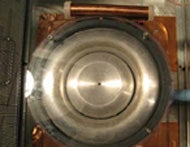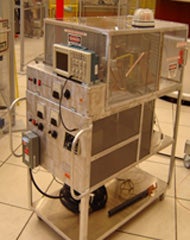Background
Heat pasteurization is a conventional method widely used by food industry to deactivate microorganisms in liquid food which otherwise would accelerate the natural deterioration (spoilage) of the fresh food. However, heat pasteurization may cause irreversible loss of fresh flavor, loss of aroma and texture, and initiation of undesirable browning reactions in beverages. Moreover, it is an energy intensive method with high utility costs. High voltage Pulsed Electric Field (PEF) treatment of food is a good alternative to heat pasteurization which preserves the natural quality of the foods and is energy efficient.
Description of the invention
University of Waterloo researchers have developed a new treatment chamber which incorporates a design that is different from other PEF treatment chambers in that it has considered both the electrical field parameters and fluid dynamics properties in the treatment process. The new design has resulted in the development of a new electrode assembly configuration for PEF treatment which unlike the conventional treatment chambers, makes effective use of the highest electric field generated, eliminates “edge effects”, and at the same time reduces turbulence by providing steady and uniform flow of the fluid under treatment, thus providing uniform treatment. The design is derived from two electrodes (one inside another) where the geometry of the outer electrode is a torus and the inner electrode is a spheroid.
Advantages
The Waterloo design is such that the inter-electrode gap, which constitutes the treatment zone, is a 360o space defined by two opposing convex surfaces. This bi-convex treatment zone is unique to the Waterloo design that overcomes the problems (technical issues) identified in the literature in generating intense electric field which is essential for PEF treatment. Additionally, the flow pattern is consistently uniform and steady. No regions of the treatment zone experience any sporadic enhancement of electric field that can lead to unwanted electrical breakdown causing problems with the treated foods which is an added special feature of this configuration. All segments of fluid that pass through the treatment zone are exposed to the same amount of electric field in an identical pattern of uniform intensity. No portion of the fluid can skip the treatment and no mixing between untreated and treated foods can happen. No stagnant in flow (untreated food) exists in any region of the treatment zone, hence contamination problems are eliminated. The design allows ease of scalability for the development of industrial scale models.
Potential applications
Cold pasteurization of liquid beverages such as milk, juice, and beer.

Treatment chamber

Waterloo PEF treatment system
Reference
8810-7189
Inventor
Shesha Jayaram
Kameswara L. Lolla
Patent status
Patents issued in Canada and Brazil
Patents pending in the U.S., France, Germany, and UK
Stage of development
Working prototype built and tested and the University is seeking license and development partners.
Contact
Scott Inwood
Director of Commercialization
Waterloo Commercialization Office
519-888-4567, ext. 43728
sinwood@uwaterloo.ca
uwaterloo.ca/research